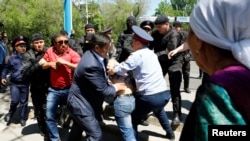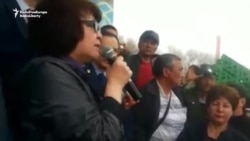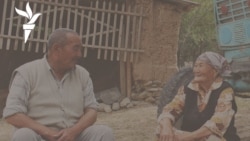It has been a year since protests broke out in Kazakhstan. The events of April and May 2016 were a shock to many inside and outside the country who had come to believe that such massive demonstrations of discontent were no longer possible there.
The first anniversary of the April 24 protest has just passed without much attention being paid to it.
What has happened in the year that has gone by since Kazakhstan saw the biggest protests in the country's 25-year history? Were the concerns of protesters allayed? Or was it something else? Or was it a combination of factors?
To look at what has happened in Kazakhstan since the spring 2016 protests, RFE/RL assembled a Majlis, or panel, to review the events that have occurred in Kazakhstan since April 2016.
Moderating the discussion was RFE/RL Media Relations Manager Muhammad Tahir. Aigerim Toleukhanova, a journalist for the Conway Bulletin, took part in the discussion from Kazakhstan. The Majlis was joined from Washington, D.C. by Reid Standish, an associate editor at Foreign Policy magazine, who has written extensively on Central Asia. I was just back from vacation, rested and ready, so I also took part in the proceedings.
Popular Unrest
Popular unrest was sparked in April last year by the Kazakh government's plans for land reform, which included privatization and the possibility of foreigners being able to lease land. "Foreigners" were interpreted by some in Kazakhstan to mean Chinese.
According to Toleukhanova, "this anti-Chinese movement was sparked first on social media."
Some of the information posted on these sites was downright false, especially claims that Chinese would be able to buy Kazakh land. There was a provision to lease land to foreigners, but there was never any proviso allowing any foreigner to own any of Kazakhstan's land.
"A big part of the fear over this land issue [was the] idea that this land would be rented out to the Chinese government or to Chinese settlers and that Kazakhs were the ones who would lose," Standish said,
In western Kazakhstan, in cities such Atyrau and Aqtobe, where people had long felt neglected by the authorities, protests started on April 24, 2016, and continued for several days.
WATCH: Kazakhs Protest Land Privatizations
The Kazakh government then announced it was suspending plans to implement the land-reform package.
But that issue opened the gates to other grievances, as Standish pointed out.
"These protests were about land issues but they became this catch-all for a lot of other anxieties and frustrations that people have with the government of the country," he said.
WATCH: Kazakh Protests Spread
In Toleukhanova's view, "People [were] disgusted [with] corruption and probably [the] dead political environment, fake elections, and all of these things that before they didn't pay attention to or didn't discuss, but with this land movement people became more open and more willing to discuss this."
Toleukhanova said the protests in western Kazakhstan were "a shock both for the authorities and the people."
Ineffective Media
As surprising as the protests were for the authorities, the inability of the government to use media to calm the situation was just as troubling.
"The government tried to use state media a lot to communicate with its own people," Standish said, adding that the ineffectiveness of this communication "was quite surprising for a lot of officials."
Standish explained that the government's message to people to "'go home, don't come out and protest, there are other ways to deal with this…' really didn't resonate at all with anyone."
A much larger protest was organized for May 21, mainly via social networks. Despite repeated warnings from officials not to participate, protesters took to the streets across Kazakhstan in what was arguably the biggest protest the country has ever seen.
WATCH: Kazakh Authorities Crack Down On Land Code Protests
One year later, there are no signs that the events of spring 2016 could be repeated any time soon.
How did the situation go from critical to calm in the span of a year?
Toleukhanova said, that, after the May 2016 protest, "the government indeed did try to listen to people's voices. For example, they created a land commission. although most of the [commission members] were not from the opposition."
Standish agreed that the Kazakh government has shown "some movement, or at least [is] trying to create the appearance of movement so that people don't need to go out into the streets to express their frustrations."
Carrot And Stick
Kazakh authorities, however, have resorted not only to the carrot, but to the stick as well.
It was noted in the conversation that many of the bloggers or other people who posted messages and information about the protests were subsequently detained and some were incarcerated.
Toleukhanova explained: "After these protests, there was the creation of a new Ministry of Information and Communication, which is also, I think, a response of the government to the people, maybe to show that they're trying to communicate with [their] own people."
However, she added that this ministry is the one pushing "to change media law, [which] is becoming more restrictive to journalists."
Another big change between spring 2016 and spring 2017 is Kazakhstan's economic situation.
New Realities
The effects of the drop in oil prices on world markets hit Kazakhstan hard, as oil is one of the country's major exports. The government allowed the national currency, the tenge, to float toward the end of 2015 and by January 2016 it had lost half its value to the U.S. dollar.
Many people in Kazakhstan had taken out large loans based on the dollar rate during the previous decade, when the country's economy was thriving and often saw an annual growth in gross domestic product that was near or more than double-digits.
Protests by homeowners were already occurring in early 2016, much smaller than those in spring, but in hindsight, these were warnings of festering discontent among the population.
For the time being, it appears Kazakhstan's people have settled into the new realities of life. The economic situation has stabilized and the tenge has even strengthened a bit, largely due to slightly higher oil prices on world markets.
Land reform plans have been suspended and won't come into effect any time before Kazakh President Nursultan Nazarbaev's current term of office expires in 2020.
The immediate future does not look so gloomy anymore.
But, as Standish pointed out: "It's interesting to see that, even [after] 25 years of post-Soviet independence, this sort of push, a voice from the people, is not gone even in a country that's authoritarian like Kazakhstan.”
You can listen to the full discussion here:
Listen to or download the Majlis podcast above or subscribe to the Majlis on iTunes.












